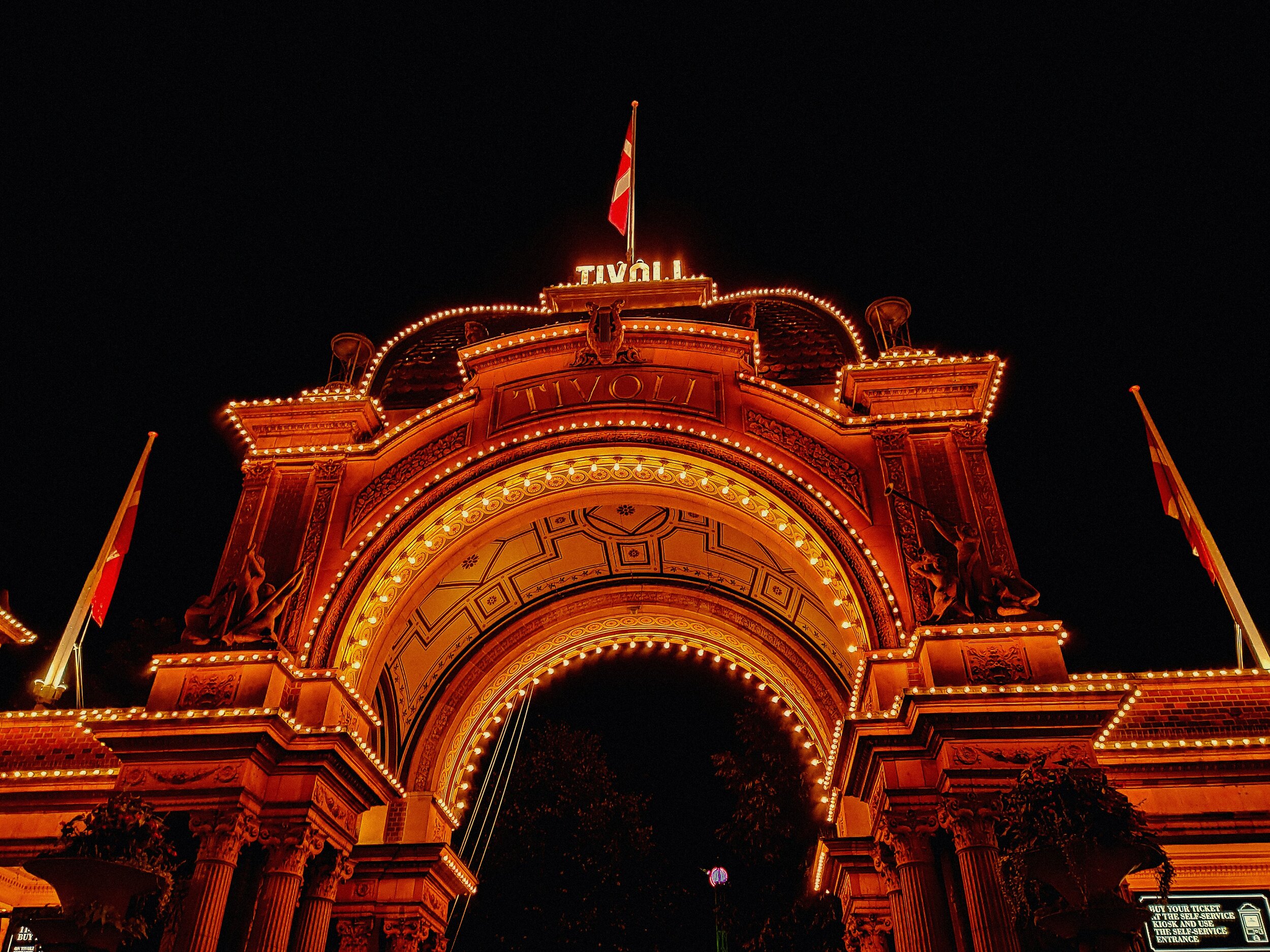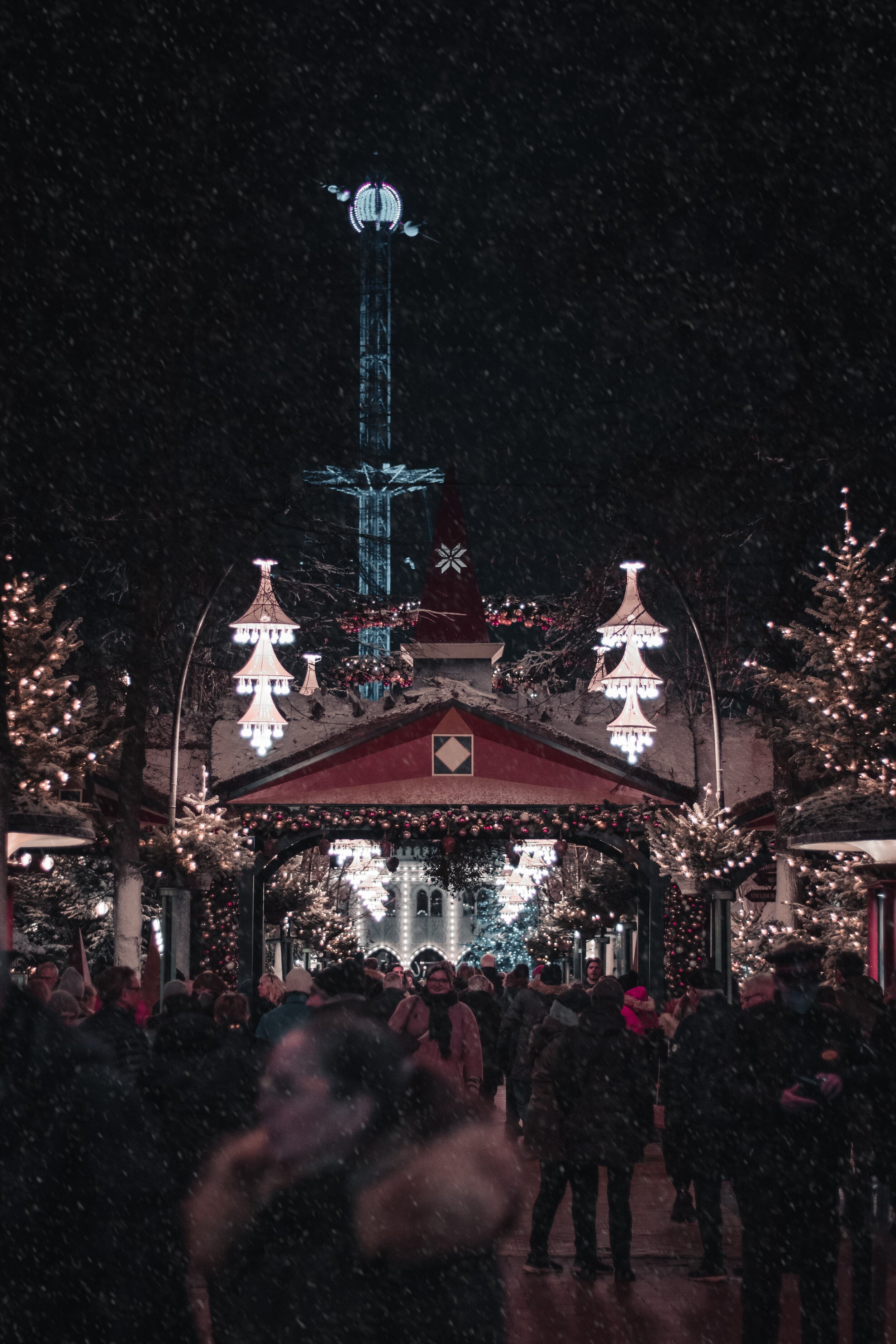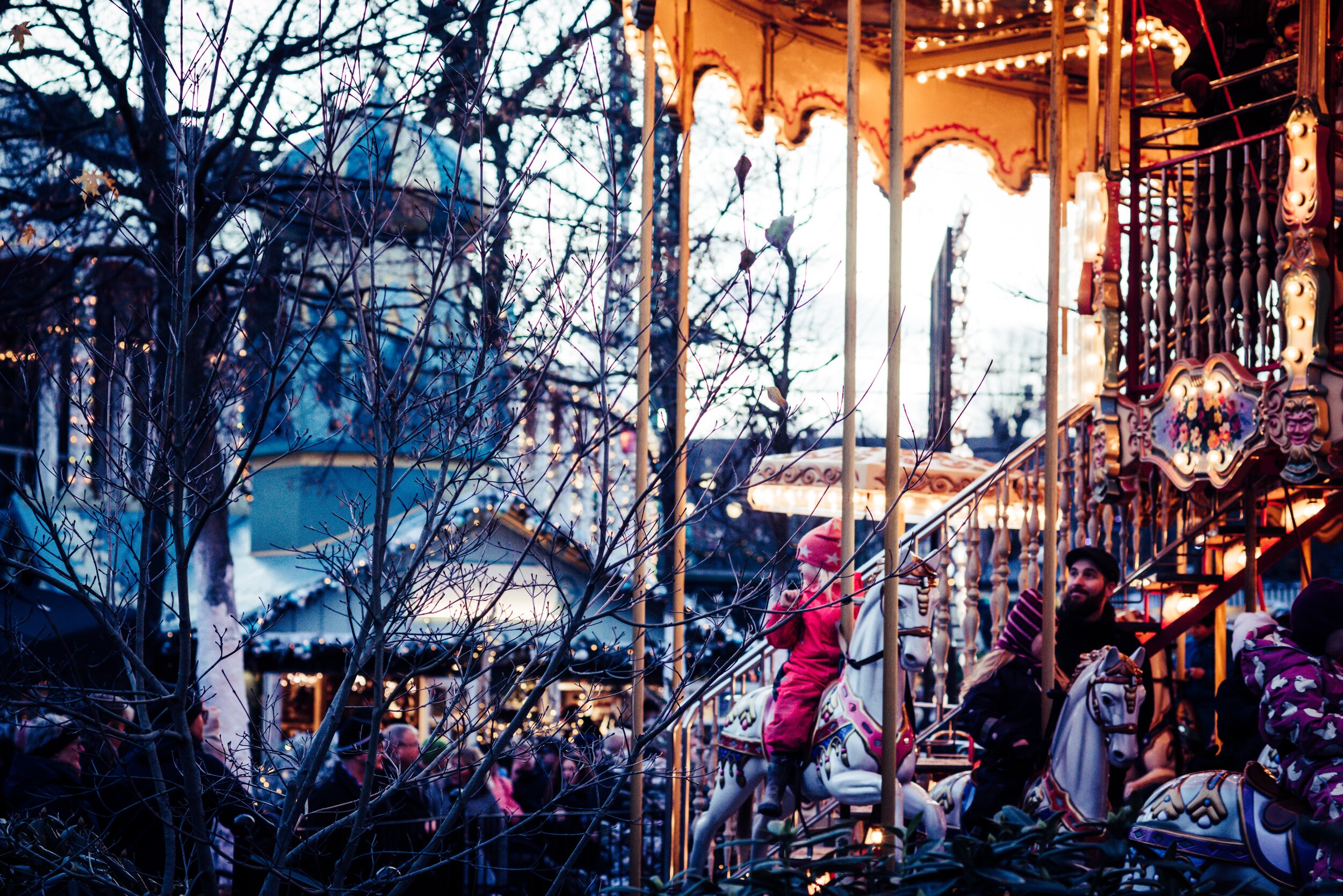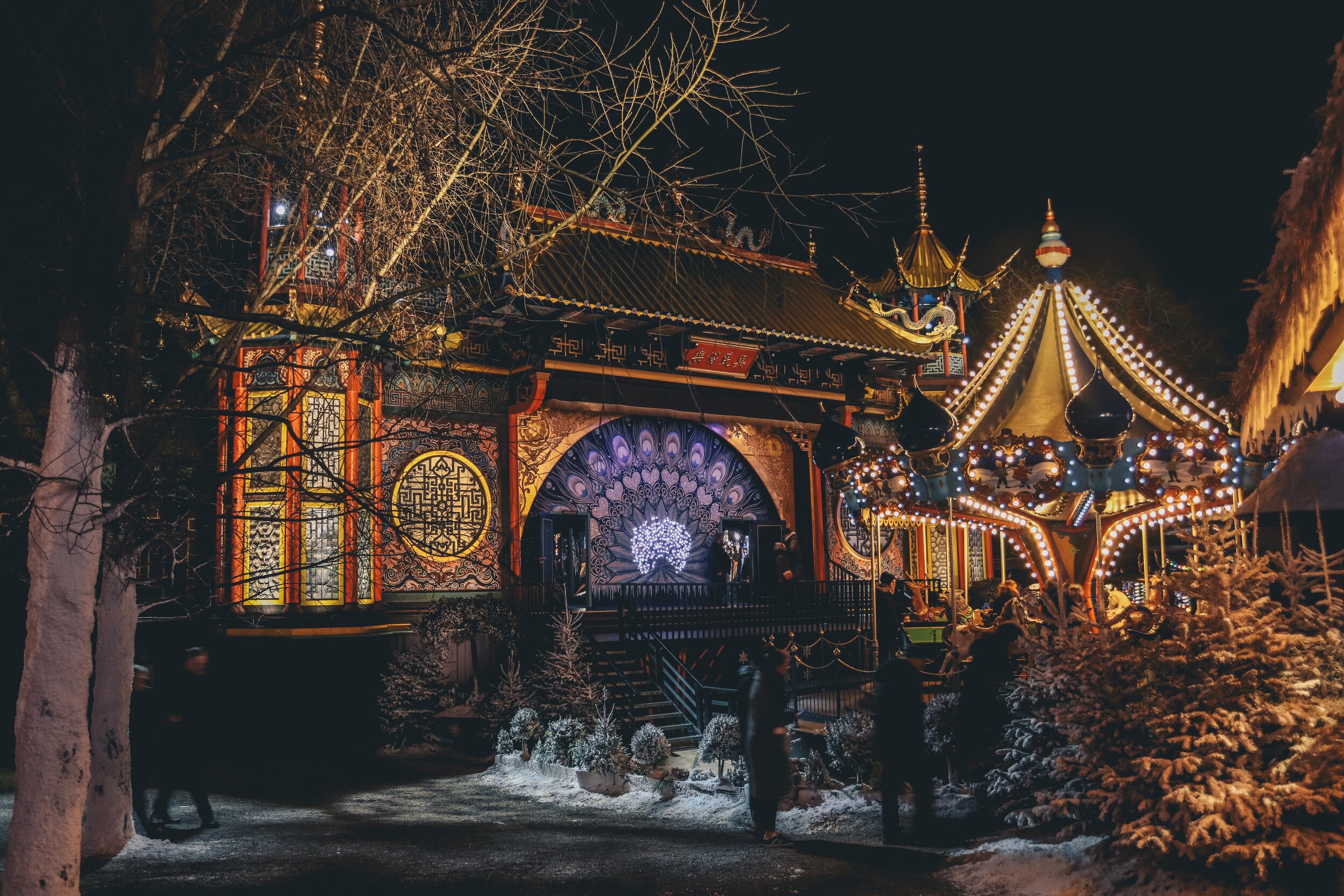Visit Tivoli Gardens in Copenhagen
At the centre of Copenhagen lies the Tivoli Gardens, one of the world’s oldest amusement parks, and Walt Disney’s inspiration for Disneyland. Since the 1840s, the rides, arcades, shops, music halls, gardens and restaurants have delighted and entertained guests from across the world.
It hardly needs stating that Tivoli is consistently the number one attraction in all of Denmark. With its unmissable turrets and rides, the gardens are a focal point of the city of Copenhagen, and often the first sight to greet a traveller when they emerge, bleary-eyed, from the Central Train Station.
Unlike amusement parks of the 21st century, Tivoli still retains a old-fashioned charm despite the millions of tourists who flock there every year. Chinese pagodas, a pirate galleon and illuminated gardens guide visitors past the stalls, 40+ restaurants, aquarium and lakes.
As a non-Dane living in Copenhagen, my memories and associations of the city before moving here all begin with childhood trips to the Tivoli Gardens.
In this guide I’ll tell you a bit about the history of these amazing gardens, then have a look at what to see in Tivoli, when to visit and what it costs.
‘Tivoli & Vauxhall’
Despite its central location in modern Copenhagen, the original Tivoli’s construction in the 19th Century lay outside of the fortified city by Vesterport (The Western Gate). It is only in the past 200 years that the city has expanded to surround and subsume the site. The lake which now lies at the centre of the park is actually part of the moat; a deep defensive fortification of the old city, around which Tivoli was built.
The founder of the gardens was called Georg Carstensen and received permission to build the attractions in 15 acres of land, from the King (Christian VIII) on the premise that:
“When the people are amusing themselves, they do not think about politics”
Opening in 1843, the gardens were originally called "Tivoli & Vauxhall"- the "Tivoli" coming from the Jardin de Tivoli in Paris and "Vauxhall" alluding to Vauxhall Gardens in London. Among the first visitors to the park was Hans Christian Andersen, who was inspired by it to write the fairy tale ‘The Nightingale .
Amusements for all
Unlike its neighbour to the north at Bakken in Klampenborg (see my guide here), Tivoli has, from day one, had a wide range of attractions for the public from day one (Bakken was originally the source of a natural spring from which stalls, tinkers and entertainers began plying their trade - it wasn’t until several centuries after its foundation that a formal ‘Amusement Park’ was built).
The 19th century was a time of expansion and empire-building across Europe, and the attractions on display in the 1843 Tivoli reflected that. A Chinese pagoda in the ‘oriental style’ was opened as a theatre (a building in a similar style can be seen at Frederiksberg Park see my guide here) - which was used as a teahouse for royal outings) band stands, firework displays and ornate flower gardens with new and exciting specimens from across the globe. Traditional ‘rides’ which we now associate with such parks were also available, with a carousel and miniature railway to transport visitors about the site.
Over the next century, more and more amusements and attractions were added to the gardens, with new restaurants, casinos and grander entrances for the public.
Tivoli had a roller coaster at its original opening in 1843, but to the indignation of the Danish public, the ride only lasted 7 seconds! In 1914 a newer version was added, and this wooden rollercoaster is still in operation to this day, making it one of the world’s oldest.
The Nazis leave their mark
In 1943, Denmark was firmly in the grasp of Hitler’s Nazi Party, and the Danish people’s allegiances were split between resistance and sympathy to their invaders. After the closure of Tivoli in the summer of that year, a group of Nazi sympathizers broke into the gardens and placed firebombs in the Concert Hall, the Glass Hall Theatre and the Arena Theatre and elsewhere - burning them to the ground.
However, temporary buildings were built in their place and the park was back in operation after two weeks.
An ever-growing attraction
In the last 70 years, Tivoli has continued to grow and expand what it offers visitors. This has resulted in new bandstands, concert venues (completed 1956 with 2000 seats - the largest of its kind in the Nordics) and the launch of Tivoli as a year-round site - with special events at Christmas, Winter and Halloween - the original scope of the gardens were as a summer attraction only.
Just as Walt Disney said, who visited the Tivoli gardens for inspiration in 1955 ‘Disneyland will never be completed. It will continue to grow as long as there is imagination left in the world.’
In Icelandic, Danish, Norwegian and Swedish, the word tivoli has become synonymous with any amusement park.
Rides and Concerts in Tivoli Gardens
Tivoli has around 30 rides suitable for all ages. The minimum age and height for rides are clearly signposted: solitary rides are possible from age 3 while some of the more ‘adventurous’ ones come with health warnings.
But as well as its famous rides, Tivoli is also an important cultural venue, hosting the largest classical musical festival in Scandinavia with over 50 concerts each year. When there isn’t a global pandemic, it also hosts free rock music concerts on many Friday nights, as well as other live music events throughout the year.
Dining in Tivoli Gardens
Many people bring picnics to the garden, but you can also choose from Tivoli's wide selection of restaurants. You'll find everything from traditional Danish cuisine to French bistro or Asian food.
If you’re up for a more relaxed, food stand kind of food, Tivoli has got that as well. On the corner of the park, towards the Central Station, you’ll find Tivoli Food Hall. It’s located in the building called Tivoli corner, which was built built in 2017 to a design by I.M. Pei who also created the glass pyramid of Louvre in Paris. Inside you’ll find a variety of different cuisines, from Icelandic dishes at Glò to delicious, hot flatbread at North-African Wakha.
Opening Hours of Tivoli Gardens
Tivoli is open for five periods each year:
Summer / main season - early April to late September
Halloween – mid-October to early November
Christmas – mid-November to 31 December
Winter – of February
Easter – a couple of weeks around the Easter weekend
Opening hours are usually daily from 11:00 to 23:00 (up to midnight on Friday and Saturday). All rides are open from noon with some operating earlier.
Source: TivoliGardens.com
Tivoli Admission Tickets
The basic admission tickets to Tivoli do not include any rides and unlimited-ride tickets do not include admission. Package deals are usually available but save only minimally.
Admission tickets for Tivoli are DKK135 per day for all visitors 8 years and older – admission does not include rides! Children 3 – 7 years pay DKK60 and under 3 enter for free. During the high season, prices go up a bit and even as high as DKK200 for admission after 19:00 on Fridays.
Rides are priced individually (DKK25 to 75) but it will almost always save money to buy a full all-rides ticket for DKK245 that includes all rides for the day. The Unlimited Ride Ticket Plus includes virtually reality displays on the rollercoaster and some photos (DKK295).





